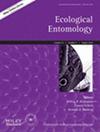House cricket males reared at different perceived acoustic population densities differ in adult behaviour but not physiology
IF 1.6
3区 农林科学
Q2 ENTOMOLOGY
引用次数: 0
Abstract
在不同声学种群密度下饲养的雄性家蟋成年后的行为不同,但生理机能并无差异
如果环境在个体一生中保持相对恒定,那么准确感知环境条件(如种群密度)的幼年个体可能会调整成年个体的特征,使其更好地适应环境,从而提高成功率。我们利用普通家蟋(Acheta domesticus),探讨了发育过程中感知到的声学种群密度是否会影响成虫的生理和行为。我们用现场雄性鸣唱模拟了高密度和低密度。成熟后,我们测量了来自不同密度的雄性之间的新陈代谢率(静息呼吸)、生殖投资(睾丸和附属腺体质量)、鸣叫特征和攻击行为。然而,高密度雄鸟的鸣叫明显更快、更长,脉冲数更多--众所周知,雌鸟更喜欢脉冲数--主频也更高。低密度雄鸟赢得了更多的攻击性比赛,也唱出了更多的攻击性歌曲。这些结果表明,雄鸟在发育过程中可能会根据感知密度对鸣叫特征和攻击行为进行弹性调整,但不会调整生理机能。总之,我们的研究强调了早期生物环境对成体行为决定的重要影响,以提高在不同环境中的成功率。
本文章由计算机程序翻译,如有差异,请以英文原文为准。
求助全文
约1分钟内获得全文
求助全文
来源期刊

Ecological Entomology
生物-昆虫学
CiteScore
4.90
自引率
4.50%
发文量
94
审稿时长
3 months
期刊介绍:
Ecological Entomology publishes top-quality original research on the ecology of insects and related invertebrate taxa. Our aim is to publish papers that will be of considerable interest to the wide community of ecologists who are motivated by ecological or evolutionary theory. The suitability of a manuscript will usually be assessed within 5 days.
We publish full-length Original Articles as well as Reviews, Short Communications, Methods and Natural History papers. In Original Articles, we greatly prefer papers that test specific hypotheses and which have a high degree of novelty. All categories aim for innovative contributions that advance the subject of ecological entomology.
 求助内容:
求助内容: 应助结果提醒方式:
应助结果提醒方式:


